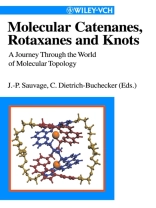This journey through the fascinating world of molecular topology focuses on catenanes, rotaxanes and knots, their synthesis, properties, and applications and the theory of interlocking and interpenetrating molecules. Nearly one hundred years of progress have passed since Willstätter’s speculative vision of a molecule consisting of two interlinked rings. But even today the synthesis of such structures are a challenge to the creativity of synthetic chemists. These molecules are not only of academic interest, since they occur naturally. In such molecules as DNA, knots and related topological features play a key role in biochemical processes. In addition, extensive research on the properties of polyrotaxanes and polycatenanes show potential applications as molecular magnets, wires or switches.
Twelve international leading experts in the field present the broad and impressive spectrum of the topology of these molecules, from theoretical aspects and new pathways in synthesis to probing their properties. All researchers working in this interdisciplinary area, whether organic, inorganic or polymer chemists, as well as material scientists, will welcome this comprehensive and up-to-date work as an inspiring source for creative research ideas.
Table des matières
Chemical Topology – Statistical Musings
A Knot – Theoretical Approach to Molecular Chirality
Soft And Hard Molecule-Based Magnets With A Fully Interlocked Three-Dimensional Structure
Transition Metal-Incorporating Catenanes
Catenanes And Rotaxanes Motifs In Interpenetrating And Self-Penetrating Coordination Polymers
Molecular Knots: From Early Attempts To High-Yield Template Syntheses
Organic Template-Directed Syntheses Of Catenanes, Rotaxanes And Knots
Amide-Based Catenanes, Rotaxanes and Pretzelanes
Polymer Chains In Constaining Environments
Polycatenanes, Poly[2]-Catenanes and Polymeric Catenanes
Polyrotaxanes: Syntheses and Properties
Synthetic DNA Topology












